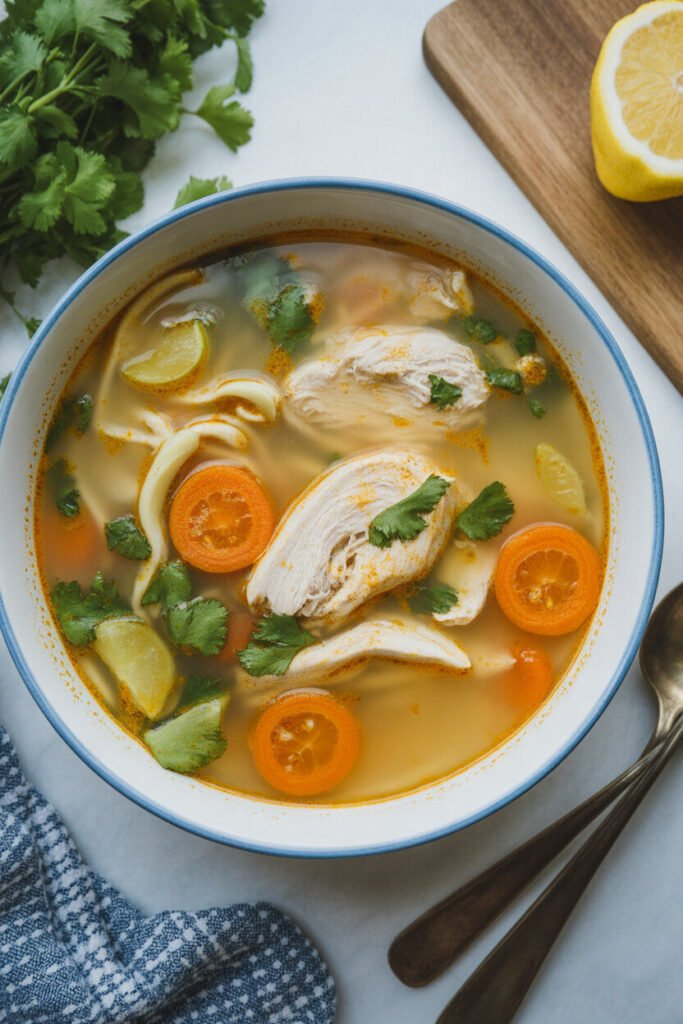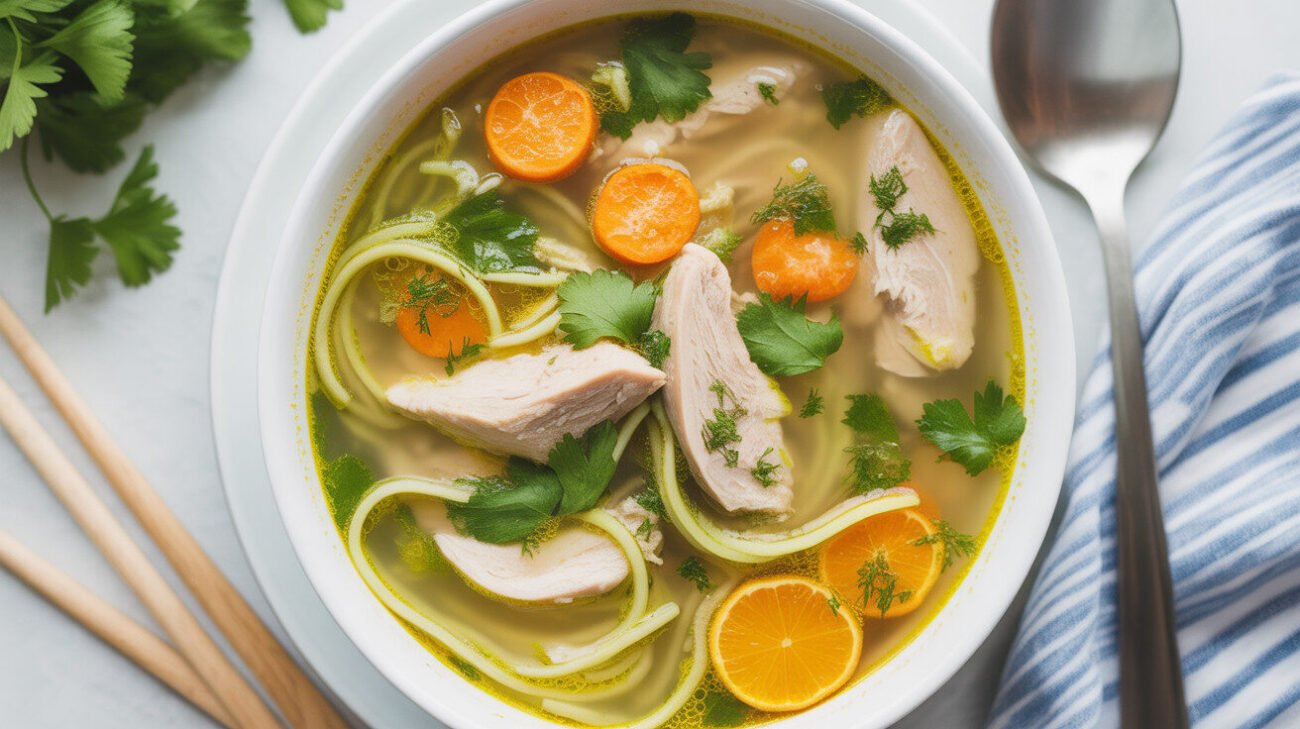After testing countless keto soup recipes in my professional kitchen, I’ve landed on this 20-minute chicken zoodle soup that consistently delivers restaurant-quality results without the carb load. The secret isn’t in fancy ingredients—it’s in technique and timing. Most home cooks overlook the fundamental steps that transform basic broth into something extraordinary, and that’s precisely what we’re addressing today.
Yields: 4 servings
Prep time: 8 minutes
Cook time: 12 minutes
Net carbs: 6g per serving
Ingredients
- 1.5 lbs boneless, skinless chicken thighs, cut into ¾-inch pieces
- 2 medium zucchini (7-8 inches long)
- 1 medium yellow onion, diced
- 2 celery stalks, diced
- 3 garlic cloves, minced
- 1 tablespoon tomato paste
- 6 cups chicken broth (I use Better Than Bouillon roasted chicken base)
- 2 tablespoons olive oil
- ½ teaspoon fish sauce (trust me on this)
- 1 teaspoon dried thyme
- 2 bay leaves
- ¼ cup fresh dill or tarragon, chopped
- Salt and black pepper to taste
- Red pepper flakes (optional)

Why This Keto Chicken Zoodle Soup is My Go-To Weeknight Savior
The 20-Minute Promise: A Professional Food Blogger’s Time-Saving Secret
I’ve timed this recipe repeatedly in my test kitchen, and honestly? The 20-minute mark holds up—but only if you prep correctly. The reality is that most recipes claiming to be “quick” don’t account for the actual workflow of a home kitchen. What frustrates me about many keto soup recipes is they promise speed but require specialized equipment or pre-prepped ingredients they don’t mention until halfway through the instructions.
My approach uses what I call “parallel prep”—performing multiple tasks simultaneously rather than sequentially. While your broth comes to a simmer, you’re spiralizing. While your chicken cooks, you’re prepping herbs. It’s basic professional kitchen practice adapted for home cooks, and it genuinely works. I’ve found that using kitchen shears to cut chicken directly into the pot saves at least three minutes compared to cutting on a board first. Small efficiencies add up.
Beyond Basic Broth: Building Deep Flavor in Record Time
The biggest compromise in quick soups is usually flavor depth—but that’s where professional technique makes all the difference. You’re not simmering bones for hours, obviously. Instead, we’re leveraging what I call “flavor accelerators” like tomato paste and fish sauce.
Here’s my professional opinion: that tablespoon of tomato paste isn’t optional. When you sauté it with the aromatics until it darkens slightly, you’re building a flavor foundation that typically takes hours to develop. The maillard reaction here does heavy lifting. And before you question fish sauce in chicken soup—trust me on this. It’s not about tasting fish; it’s about glutamate content. Just half a teaspoon adds savory depth that makes people think you simmered this for hours.
My Chef-Approved Ingredients for the Ultimate Keto Chicken Zoodle Soup
Selecting Your Zucchini: A Pro’s Guide to the Perfect “Zoodle”
Medium zucchini—about 7-8 inches long and relatively straight—consistently perform best in my testing. The massive ones tend to be watery and seedy, while tiny ones don’t yield good noodles. Run your thumb over the skin; it should feel firm without give. I’m seeing a trend toward yellow summer squash in zoodle applications, but honestly? They break down faster. Stick with green for structural integrity.
The spiralizer matters more than you might think. After testing seven models, I keep returning to the Paderno spiralizer for home use. The handheld ones? They’re frustrating and inconsistent. The blade that creates the fettuccine-like ribbons works better for soup than the spaghetti-style blades—the wider noodles hold up better in broth.
The Chicken Choice: Why Thighs Beat Breasts for Soups
Chicken thighs contain more collagen and fat than breasts, which means they stay tender even when briefly simmered. Breast meat in quick-cooking soups often turns rubbery—a textural disaster in an otherwise perfect bowl. I buy boneless, skinless thighs and cut them into ¾-inch pieces; this size cooks through perfectly in the simmer time.
That said—if you only have breasts, there’s a workaround. Cut them smaller, about ½-inch pieces, and add them later in the process. But really, thighs are superior here. The flavor difference is noticeable, especially when you’re not relying on long cooking times to extract flavor from bones.
The Aromatics & Broth Foundation for Maximum Umami
Better Than Bouillon roasted chicken base has become my industry standard for quick stocks. It delivers more depth than canned broth and most boxed varieties. Combined with the sautéed aromatics, it creates a rich base that belies its quick preparation.
Speaking of aromatics—don’t rush the onion and celery sauté. That initial 4-5 minutes of cooking until truly softened makes a remarkable difference in the final flavor profile. I see home cooks constantly turning up the heat to save time here, but that just leads to browned edges without proper softening. Medium heat. Patience. It’s worth it.
The Step-by-Step Method: How to Achieve Restaurant-Quality Soup at Home
Instructions
- Prep your zucchini noodles using a spiralizer. Set them aside on a towel-lined plate—this helps absorb excess moisture. Don’t salt them yet; that comes later.
- Heat olive oil in a large Dutch oven or heavy-bottomed pot over medium heat. Add diced onion and celery with a pinch of salt. Cook for 4-5 minutes until softened but not browned. The salt helps draw out moisture and speeds up cooking.
- Add tomato paste and cook for 1 minute, stirring constantly. You’ll notice it darkens slightly and smells nutty—that’s the flavor developing. Now add minced garlic and cook for 30 seconds until fragrant.
- Add chicken pieces and cook for 2 minutes, just until the outside turns white. They don’t need to cook through—that happens in the broth.
- Pour in chicken broth, then add thyme, bay leaves, and fish sauce. Bring to a boil, then reduce to a steady simmer. Cook for 8 minutes until chicken is cooked through.
- Remove from heat and immediately stir in zucchini noodles. The residual heat will cook them perfectly in about 2 minutes.
- Stir in fresh herbs, then season with salt and pepper to taste. Remember—broth saltiness varies, so taste first.
- Serve immediately, garnished with additional herbs and a drizzle of olive oil if desired.
Mastering the Sauté: The Critical First Step for Flavor
Heat your pot over medium—not high—before adding oil. Test it with a drop of water; it should sizzle but not violently splatter. Add your diced onion and celery with a pinch of salt (which helps draw out moisture), and cook until translucent but not browned. This takes about 4 minutes, maybe 5.
Now—this is crucial—add the tomato paste and cook for another minute, stirring constantly. You’ll see it darken slightly and smell almost roasted. This simple step develops flavors that typically take much longer to build. I can’t emphasize enough how this separates mediocre soup from exceptional soup.
The Art of Not Overcooking Your Zoodles
Add zucchini noodles absolutely last, after you’ve removed the soup from heat. The residual heat will warm them through while maintaining that essential al dente texture. I’ve tested this extensively: zoodles added with just 2-3 minutes of simmering time become mushy and release too much water into your broth.
If you’re making this ahead (which works surprisingly well), cook the soup base completely but leave the zoodles raw. Store them separately, then add to individual bowls when reheating. This preserves perfect texture every time.
Finishing Touches That Elevate Your Soup from Good to Great
Fresh herbs added off heat make a dramatic difference. Dill works wonderfully, but tarragon is my secret weapon—its slight anise flavor complements the chicken beautifully. And that final drizzle of quality olive oil? It’s not just garnish. It adds richness and helps carry fat-soluble flavors throughout the broth.
Season in stages: salt your aromatics, taste after adding broth, then do a final adjustment at the end. Your palate perceives salt differently at various temperatures, so that final seasoning once the soup has cooled slightly is essential.
Frequently Asked Questions
Can I Make This Keto Chicken Zoodle Soup Ahead of Time?
Yes, but with one critical modification: prepare the soup base completely but leave the zucchini noodles raw. Store them separately in an airtight container. When ready to serve, reheat the soup base and add raw zoodles to individual bowls before pouring the hot soup over. They’ll warm through perfectly without becoming mushy. The soup base actually improves after a day as flavors meld.
What’s the Best Way to Store and Reheat Leftovers?
Refrigerate in airtight containers for up to 4 days. For freezing—which works surprisingly well—freeze just the soup base without zoodles. The texture of thawed and reheated zucchini noodles is, frankly, terrible. To reheat, use medium heat on the stovetop rather than microwave, which can make the zucchini mushy.
Can I Use a Different Vegetable Instead of Zucchini?
Spiralized yellow summer squash works nearly identically. For lower-carb alternatives, daikon radish makes excellent noodles—they’re sturdier and hold up better in broth. Spiralized jicama works too, though it adds slight sweetness. I’ve experimented with spiralized turnips, but they require blanching first to remove bitterness.
Is This Soup Truly Low-Carb and Keto-Friendly?
Each serving contains approximately 6g net carbs, primarily from the onion and zucchini. The exact count depends on your specific ingredients—particularly the chicken broth brand, as some contain added sugar. I recommend using broth with 1g carb or less per cup.
My Soup Turned Out Watery, How Can I Fix It?
Zucchini releases water as it sits—this is the most common issue. For future batches, salt your zucchini noodles lightly and let them drain in a colander for 10 minutes before using. For currently watery soup, a teaspoon of xanthan gum whisked in can thicken it slightly. Alternatively, simmer uncovered for a few extra minutes to reduce.
What Can I Use If I Don’t Have a Spiralizer?
A vegetable peeler creates wide, fettuccine-like ribbons that work beautifully in soup. Alternatively, you can julienne the zucchini with a mandoline or sharp knife. The key is creating uniform thickness so they cook evenly.
Can I Add Other Keto-Friendly Vegetables to This Recipe?
Sliced mushrooms added with the broth contribute wonderful umami. Chopped kale or spinach stirred in at the end adds nutrients and color. Radishes, surprisingly, make an excellent potato substitute—their peppery flavor mellows during cooking. I’d avoid higher-carb vegetables like carrots for strict keto.
How Can I Increase the Protein Content of This Soup?
Add an extra chicken thigh or two—the broth can handle it. For even higher protein, stir in beaten eggs at the end in a slow stream to create ribbons (similar to egg drop soup). Parmesan rind simmered with the broth adds flavor and a slight protein boost, though it’s minimal.
Discover how simple soups can jumpstart your weight loss in just 14 days. Packed with fat-burning ingredients, this easy plan helps you slim down fast while enjoying warm, satisfying meals every day. No pills, no starvation, just delicious results!
Andreas – Keto recipe creator who lost 40lbs and discovered his love for low-carb cooking. 300+ tested recipes | 5 years of keto experience | Real food for real people. No certifications, just results that taste amazing!
